How to learn to skate from scratch?

Skateboarding continues to maintain one of the leading positions among active sports. Today, both an adult and a child can easily acquire the appropriate equipment and stand on the board, but acquiring the necessary skills turns out to be more difficult than learning a theory. How to learn how to skate, what equipment you have to buy, where is the best place to grasp the basics of board management from scratch - let's talk about this in more detail.
Equipment requirements and training site
There are certain rules for choosing a place and equipment for skiing. For children and adults who are just learning the basics of skateboarding, be sure to take care of the purchase of suitable clothing and footwear, as well as protective equipment. Helmets, knee pads, elbow pads, protective shorts, palm pads are needed not only for boys and girls. An adult can also be injured if he falls without equipment.
Special footwear is the key to success. Sneakers designed for skateboarding provide the highest quality traction. Their outsole is made of durable materials that are not afraid of intense abrasion.
Not suitable for skateboarding are the textured soles found in most other sports.
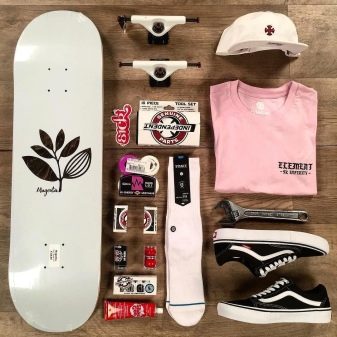
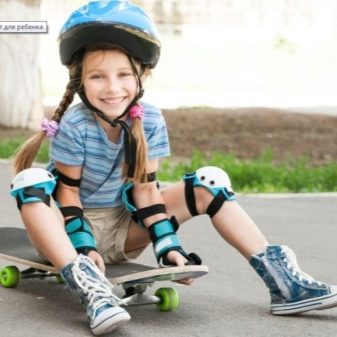
A skate for beginners should be quite wide - on average 20.3 cm, 78.5 cm long. These are universal parameters that make it easy to master the riding technique. The suspension of the first skateboard should be aluminum, not protruding beyond the edges of the board. Beginner board bearings are generally in ABEC grade 1 to 3. Do not chase the large size of the wheels - it will become a hindrance in learning.
When choosing a site for skiing, beginner riders should give preference to smooth concrete or asphalt surfaces without pronounced irregularities, cracks and other obstacles. The training area should not be crowded with pedestrians or small children. Riding on the carriageway, driving on highways or public roads is strictly prohibited.
Sidewalks, especially crowded ones, are not suitable for skiing, but the territory of a park or square with a high-quality asphalt surface is quite suitable.
It is best to stick to the edge of the accessible lanes at first so as not to interfere with those riding the scooter or rollerblades at a higher speed. When choosing a place, it is recommended to make a preliminary inspection, carefully study the territory - a pothole or a manhole that appears on the way can cause a fall.

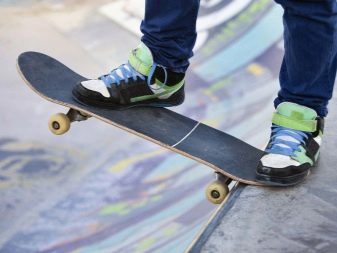
Basic elements
Let's take a look at what elements and exercises for beginner skaters are required to learn. To master skateboarding, you must first learn to stand on it. The correct setting looks like this:
- the body is located across the board;
- feet are shoulder-width apart, above the wheels;
- knees slightly bent;
- hands can be spread;
- the face is turned in the direction of movement;
- when transferring weight to the toes, the rollers under them should move closer together;
- when the center of gravity is shifted to the heels - the same thing.
Actually, maneuvering consists in changing the load on the left or right edge of the board. This is a basic control technique. Having mastered the stand "on the ground", out of the blue, you can move on to movement. To properly learn to skateboard from scratch, it is enough to put one foot on the board, and the other to give acceleration, pushing off with it from the asphalt. There is no need to rush, you will hardly be able to quickly master the basics, you will have to spend some time.
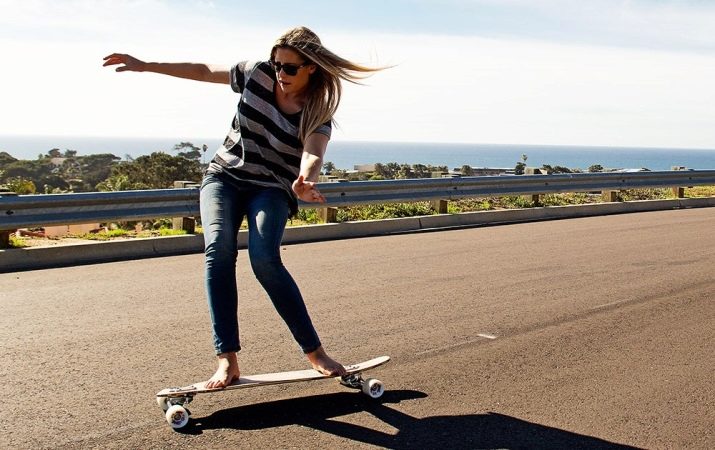
Driving in a straight line
The ability to ride in a straight line is the foundation of skateboarding. The athlete must first decide on the jogging leg. It becomes the one that is most convenient to push off from the asphalt. For most people, this is the right leg, but it is better to experiment on your own and make the final decision.
To start walking in a straight line, you first need to take a basic position - with two feet on the deck. Then the supporting leg gently lowers to the asphalt, makes a push and returns to the board again. No need to hurry - the first attempts should allow the skater to feel the balance, there is no need to set a speed record here.
Having mastered, you can gradually increase the activity of skiing.
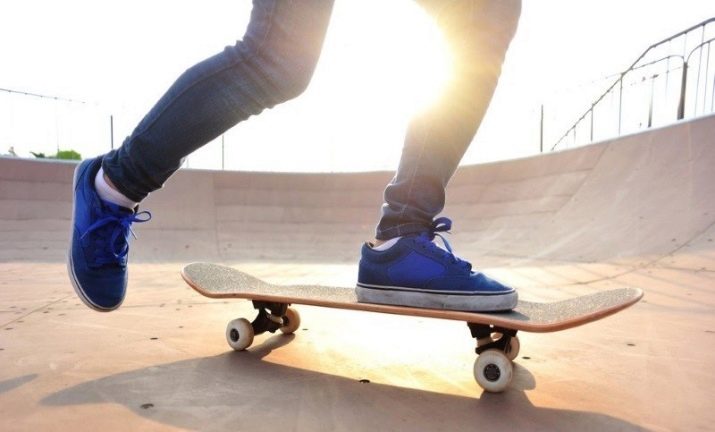
Smooth and sharp turns
The ability to maneuver is an important component of successful skiing... Beginners are encouraged to master smooth turns. To do this, it is enough to learn how to transfer body weight on heels or socks - always in the direction where you have to go. The body also tilts towards the inner turning radius. The stronger the pressure, the sharper the angle of change of the trajectory will turn out.
Sharp turns are carried out as you gain experience, since for them the skater must be able to balance only on the rear wheels of the board. In this case, the lift of the nose of the board from the ground is used by transferring the weight back. In this position, a body jerk is made, allowing you to change the direction of movement in the desired direction. As soon as the goal is achieved, the front wheels are lowered to the ground again, balance is restored.
For beginners in skating, the ability to make sharp turns is simply not necessary. First, you need to master the gradual transition from driving in a straight line to taxiing. Having learned how to smoothly change the direction of movement, you can already leave the training area. Do not be afraid of falls or emergency dismounts from the board. Gradually building up practical experience, you can master a fairly confident riding and maneuvering.
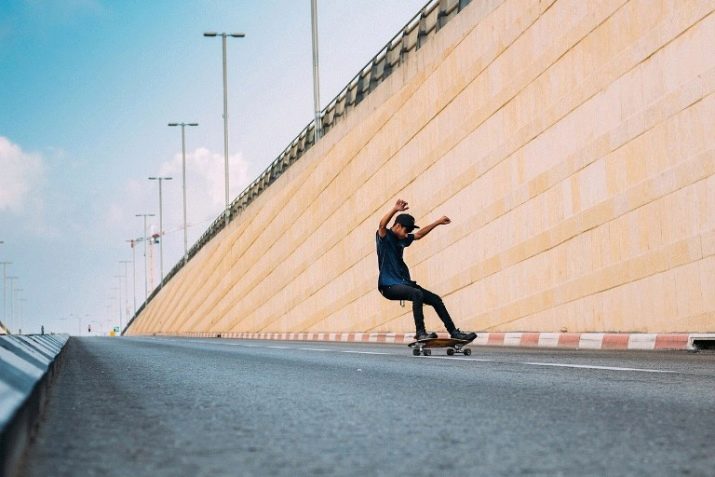
Braking
The decrease in speed when riding a skateboard occurs by shifting the supporting or jogging leg to the tail of the board, while transferring body weight to it. This will allow you to slow down and achieve a smooth stop or a speed that is acceptable for exiting the deck. If emergency braking is performed, you need to fully lean on the leg placed in the tail, applying maximum force. At the same time, the edge of the board will come into contact with the asphalt, the nose will be in the air.
When riding on a flat surface, you can do even easier. Braking with your foot on the asphalt is important for beginners and does not require great riding skills.
If there is a real danger ahead and there is no time to stop, you need to jump from the skate forward, in the direction of travel.

Tricks and Exercises
Not all boards are suitable for performing tricks on a skateboard. Cruisers with straight edges are not suitable for this purpose. Narrow and light boards with raised nose and tail can be used for trick riding, jumping on them and performing difficult maneuvers. You can proceed to a new stage only after the basic elements have been fully worked out.
To help beginners - watching real skiing in the park. Do not immediately try to repeat all the tricks performed by the masters. For beginners, only the simplest, basic exercises are suitable, among them several can be distinguished.
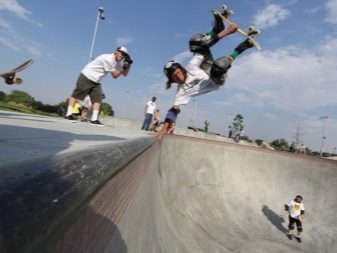
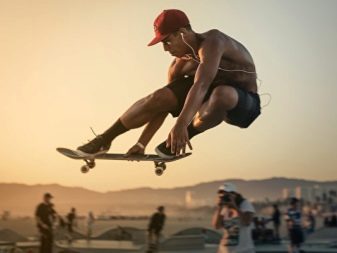
Kickflip
This trick element belongs to the basic and must be mastered. This is a deck scrolling performed with a jump at a good acceleration. Legs from a position shoulder-width apart are positioned so that the leader is at the edge of the board.
Next, a click is made on the back of the board, with pressure and bounce from the back. It is performed with the supporting leg, it is repelled, while the leading one is extended, bending inward and directing the deck forward and up. At the same time, the board rises into the air, and the skater's knees are pressed against the chest. Once the skate is finished spinning, you need to catch it with your feet and wait until it lands, keeping your knees bent to soften contact with the asphalt.
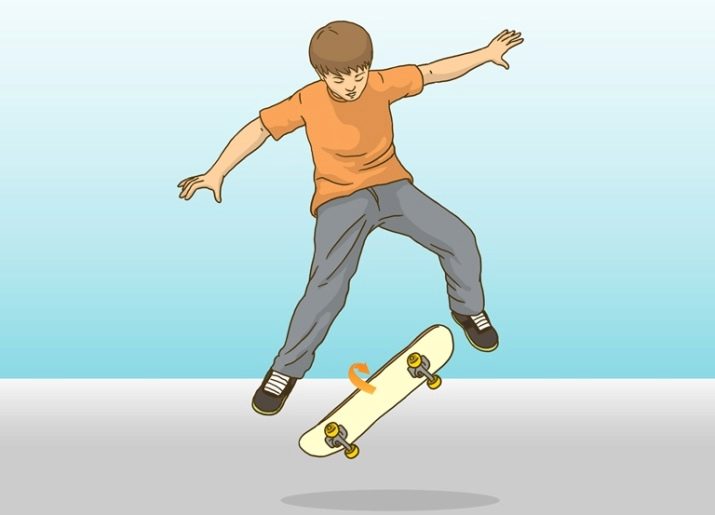
Ollie
The moment of flight that occurs after the click-and-draw link is completed is called an ollie. It is he who underlies most of the tricks, so it is recommended to devote as much time as possible to practicing the element. The board seems to be glued to the athlete's feet, and it looks very impressive.
To get an allie clean, you need to learn how to accelerate well and correctly transfer body weight. And you will also need the skill of pushing off the ground along with the skate. In this case, while the jogging leg performs its role, the leader must continue to move up and down the deck.

50-50 Grind
This is the name of the jump performed to the edge. To do it, you need to get good overclocking. Then a stance is taken with the leading foot at the front edge and when approaching the dais to be jumped on, a movement similar to that needed for an ollie is performed, with the deck moving to the edge. You can also jump using olly.
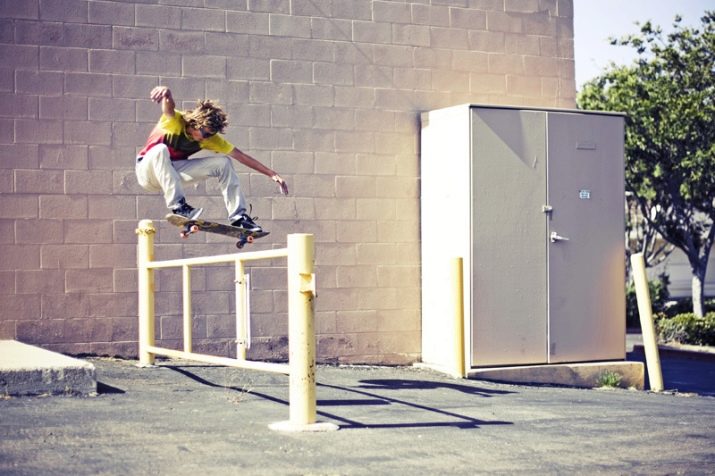
BB Pop shove it
This is one of the easiest tricks for beginner skaters. It consists in a jump with a 180-degree spin of the board. It is performed in the same way as an ollie, only the leg does not slide during the jump, but stops in the center of the deck. At the moment of clicking on the ground from behind, the leg located in the tail is used to control the skate when turning.
These basics of trick riding will be enough for a beginner to master more complex techniques and improve their skills.

Basic mistakes of beginners
Learning to skate for beginners always starts with mastering the simplest movements. A well-built base is half the battle when it comes to skateboarding. It is also worth looking into the experience of more advanced riders to avoid common mistakes beginners make.
What are the most common mistakes beginner skaters make? One of the most common mistakes is skating in unfamiliar places, trying to test skate on a dirt or uneven road. At best, such an experiment will end in a fall, at worst, you can damage the skateboard and get yourself injured.
Do not rely solely on the good faith of the manufacturer. The skateboard needs regular checks, lubrication of bearings, periodic replacement of wheels, it may have loose mountings. It is recommended to carry out an inspection before each ride.
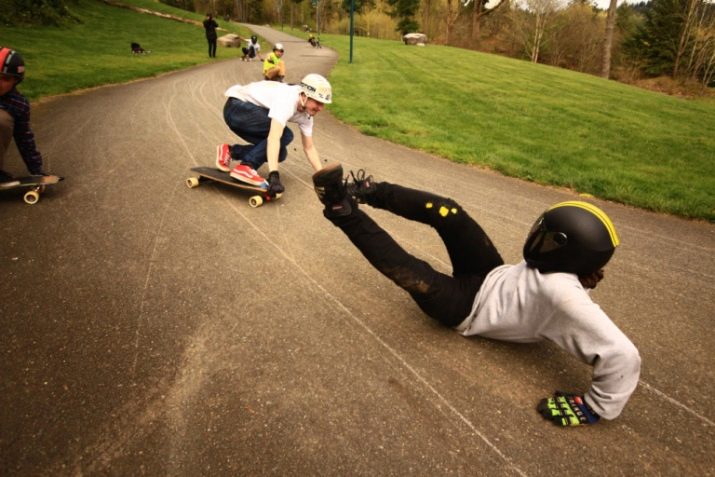
Excessive desire for speed skating is a big mistake for beginners.
They often choose large boards - longboards, trying to move to overclocking as quickly as possible. But the speed must always match the skill of the skater.... And learning the basics for both children and adults is much easier on the board in size.
Jumping back, against the direction of movement. This is the wrong tactic and can lead to serious injury. Jumping off the skate while moving is recommended only forward, in the direction of movement - it is much easier to maintain balance and not fall.
Overly vigorous push-off when rolling. Short thrusts in a series cause the board to lose balance. With a strong, long repulsion, this does not happen.
For information on how to learn how to skate from scratch, see the next video.








